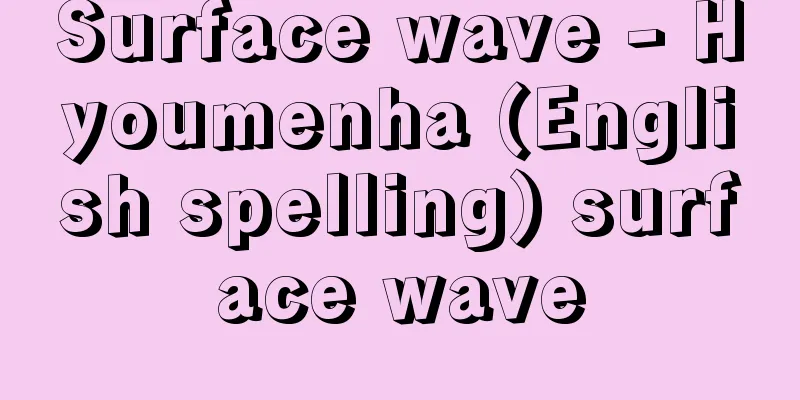Surface wave - Hyoumenha (English spelling) surface wave

|
A wave that travels along the surface or boundary of a medium. The wave's energy is concentrated near the surface (boundary) of the medium. In elastic bodies, there are two main types of surface waves: Rayleigh waves and Love waves. Both propagate along the surface of the medium. In the case of Rayleigh waves propagating through elastic bodies with a uniform structure, points on the surface of the medium move in a vertical elliptical orbit that includes the direction of wave propagation. The direction of rotation is backwards to the direction of wave propagation at the top of the ellipse. In this case, the propagation speed of the Rayleigh wave is approximately 0.9 times the S-wave speed. Love waves exist when there is a layer with a slow S-wave speed on the surface. Points on the surface vibrate in a direction perpendicular to the propagation direction of the Love waves. In the case of Love waves, the phenomenon that the propagation speed of the wave varies depending on the wavelength, that is, dispersion, is observed. In the case of Rayleigh waves, dispersion is also observed if the medium has a layer structure. The curve that shows the relationship between the propagation speed of the surface wave and the wavelength (or period or frequency) is called the dispersion curve. Based on the dispersion curve obtained by observation, the rough distribution of seismic wave speeds inside the Earth can be estimated. [Teruo Yamashita] OceanGenerally speaking, gravity waves are waves that travel along the surface of a fluid and attenuate rapidly with depth, but in the ocean or lake, they are gravity waves whose wavelength ( L ) is shorter than twice the bottom depth ( H ). When L = 2H , the wave motion at the bottom is 1/23 of the wave motion at the surface, and the wave motion is limited to near the surface. Therefore, the relationship between wavelength and period ( T ) and the wave speed ( C ) are not affected by the bottom depth. Therefore, surface waves are also known as deep-sea waves. If g is the acceleration of gravity, L = gT2 / 2π, C = L / T = gT /2π. The wavelength of wind waves is several tens of meters, while the wavelength of swells is around 200 meters, so in the open ocean, both are surface waves. When surface waves reach the coast and the ocean becomes shallow, the wavelength becomes shorter, but the ocean also becomes shallower, so the relationship L ≦ 2H no longer holds. When L ≧ 10H , they are called long waves or shallow water waves, and the wave speed is proportional to the square root of H.
When the density of a fluid changes with depth, gravity waves can occur inside the fluid. These are called internal waves. Waves that occur on the surface of a fluid are sometimes called surface waves to distinguish them from internal waves. [Kenzo Takano] [Reference item] | |Source: Shogakukan Encyclopedia Nipponica About Encyclopedia Nipponica Information | Legend |
|
媒質の表面や境界面に沿って伝わる波。媒質の表面(境界面)付近に波のエネルギーは集中する。 弾性体の場合、おもな表面波にレイリー波Rayleigh waveとラブ波Love waveの2種類がある。両者とも媒質の表面に沿って伝わる。一様な構造をもつ弾性体を伝わるレイリー波の場合、媒質の表面上の点は波の伝播(でんぱ)方向を含む垂直面内で縦長の楕円(だえん)軌道を描くように運動する。その回転方向は、楕円の上端で波の伝播方向に対して後ろ向きである。この場合レイリー波の伝播速度はS波速度のほぼ0.9倍である。ラブ波は、S波速度の遅い層が表面にあるとき存在する。表面上の点は表面内をラブ波の伝播方向とは直交する方向に振動する。ラブ波の場合、波の伝播速度が波長により異なるという現象、すなわち分散がみられる。レイリー波の場合も媒質に層構造があれば分散を示す。表面波の伝播速度と波長(または周期や周波数)の間の関係を表す曲線を分散曲線という。観測により得られた分散曲線を基礎にして、地球内部の大まかな地震波速度分布を推定することができる。 [山下輝夫] 海洋一般には流体表面を伝わる波のうち、深さとともに急激に減衰するものをさすが、海や湖では、波長(L)が底の深さ(H)の倍よりも短い重力波である。L=2Hの場合、底での波動は水面の23分の1であり、波動は水面近くに限られている。したがって波長と周期(T)の間の関係や波速(C)に底の深さは関与しない。それで表面波の別名は深海波である。 gを重力の加速度とすれば、L=gT2/2π、C=L/T=gT/2π。 風浪の波長は数十メートル、うねりの波長は200メートルくらいだから、外洋ではどちらも表面波である。表面波が海岸近くに達して海が浅くなると、波長は短くなるが海も浅くなっているため、L≦2Hの関係が成り立たなくなる。L≧10H程度になると、長波あるいは浅海波とよばれ、波速はHの平方根に比例する。
流体の密度が深さとともに変わる場合、流体内部にも重力波が発生することがある。これを内部波という。内部波と区別して流体表面に起きる波を表面波とよぶこともある。 [高野健三] [参照項目] | |出典 小学館 日本大百科全書(ニッポニカ)日本大百科全書(ニッポニカ)について 情報 | 凡例 |
<<: Surface hardening - Hyomen yakiire (English spelling) surface hardening
Recommend
Suomenlahti
…Official name: Republic of FinlandSuomen Tasaval...
Empress Inoue - Ikami Kogo
…Emperor Kōnin had a son, Prince Osabe, with Empr...
Senpukuji Cave - Senpukuji Cave
Located at the entrance to the castle in Setogoshi...
Ehrenfest - Paul Ehrenfest
Austrian theoretical physicist. Born in Vienna. H...
Onkou - Gratitude
〘 noun 〙 In the Ritsuryo system, when a person who...
Auriol, JB (English spelling) AuriolJB
...The basis of clowning was laid by Joseph Grima...
Agrionidae
...A general term for insects in the Agrionidae f...
Thalassoma bifasciatus
… [Makoto Shimizu]. . … *Some of the terminology ...
Nissan dispute
A labor dispute at Nissan Motors took place over 1...
G-suit - G-suit (English spelling) G-suit
The correct name for this suit is an anti -G suit....
Bucket wheel excavator
A grab ship with a bucket capacity of 35 m3 has a...
Rash
Common name for contact dermatitis. Source : Heibo...
partial denture
... Gold alloys such as platinum-gold alloys, whi...
Zhang Dong-sun (English spelling)
[Born] Guangxu 12 (1886) [Died] 1973 Chinese philo...
oxeye daisy (English spelling) oxeyedaisy
... The Chrysanthemum genus, which includes the m...









